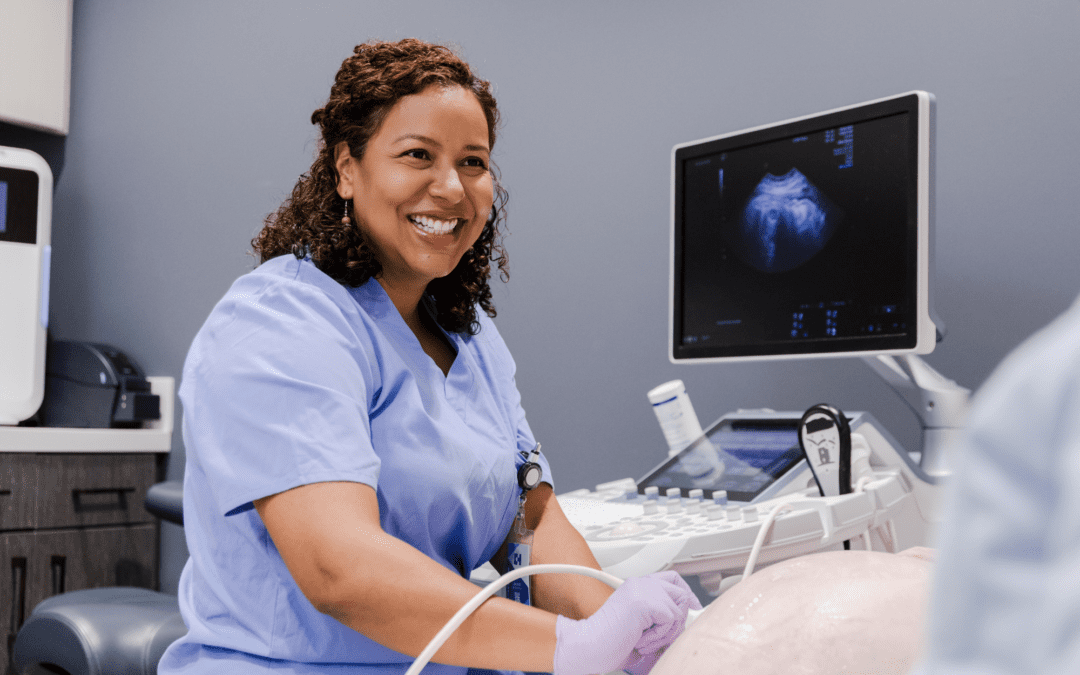Ultrasounds provide a window into your pregnancy and reproductive health. If you’ve had a positive pregnancy test, an ultrasound will answer several important questions, including:
- If the pregnancy is healthy or if you’re having a miscarriage
- Exactly how far along you are (rather than relying on your last period for a general estimation)
- If you’re having an ectopic pregnancy
Once you know this information, you can better understand the options available for your unplanned pregnancy. Use this blog to understand the ins and outs of a pregnancy ultrasound and why it’s so important.
What is an ultrasound?
An ultrasound uses sound waves to create a picture of what’s happening inside your body. Since you can’t see your uterus from the outside, these images allow the ultrasound tech, also called a sonographer, to see exactly what’s happening with your pregnancy.
Though you may be confused by the grainy black and white pictures you’ve seen from other people’s pregnancies, sonographers can use ultrasounds to see:
- The gestational sac, which forms around the embryo and holds amniotic fluid. The tech will make sure that it is located within your uterus. If you are having an ectopic pregnancy and the sac is located elsewhere, the sonographer will alert you so you can get immediate treatment.
- The yolk sac, which feeds the embryo during the early weeks of pregnancy until the placenta and umbilical cord develop. If the tech can’t see the yolk sac within the gestational sac, it may be a sign that your pregnancy isn’t viable.
- Cardiac activity, which is another way for sonographers to see if your pregnancy is healthy or if you’re having a miscarriage.
This information will help you understand your options and the next steps you can take

What should I Expect During My Ultrasound?
Once a medical-grade pregnancy test confirms that you’re pregnant, an ultrasound is the next step. We know it can be scary and overwhelming to get an ultrasound when you don’t know what to expect, so here’s a breakdown of our process to put your mind at ease.
1. Our nurse will explain the process
Before you meet our sonographer, one of our nurses will sit with you to explain the process. She will make sure you understand what the ultrasound will include, including answering any questions you may have. We want you to be comfortable and confident during your visit, so don’t be afraid to ask for the information you need!
2. You’ll get ready for the ultrasound
Next, you’ll meet our sonographer in the exam room. She will talk you through every part of the ultrasound so you understand what she’s doing and why.
The sonographer will use a wand-like tool called a transducer to scan your abdomen just above the pelvic bone. Depending on your body and the gestational age of the fetus, she may be able to get all of the images and measurements she needs.
In some cases, however, the sonographer may need to do an internal scan and use a transvaginal transducer. But don’t worry! She will talk you through each step and take careful measures to ensure you remain covered and comfortable throughout the procedure.
3. The sonographer will scan your uterus
During the ultrasound, the tech will be looking for and measuring the gestational sac. Once she finds it, she will check for a yolk sac and cardiac activity, which is the early form of a heartbeat. If everything looks healthy, she will be able to tell you how far along you are to the week and day.
If the gestational sac looks empty, there are two possibilities. First, you may be having a miscarriage. You may also be too early in your pregnancy to see the yolk sac or heartbeat. The sonographer may recommend that you return for another appointment in a week to see if she can verify the pregnancy when you’re further along.
Another way to detect a miscarriage is by measuring the gestational sac, which is also how the sonographer will see how far along you are. If she determines the embryo is underdeveloped for stage of pregnancy, you may be having a miscarriage. The sonographer may recommend coming back for another ultrasound to confirm.
4. Our radiologist will send your official report
After the ultrasound, the sonographer will send the images and information to our radiologist. The doctor will create and confirm a report of their findings, including an official recommendation for a follow-up ultrasound, if applicable. This usually takes about a week.
After we receive it, we will call you to go over the report. You can visit the clinic to sign a medical release form if you want to take the results to another medical practice for further care. If you return for a follow-up ultrasound, we will send a second report for that appointment.
At ThriVe Orlando, we’re committed to empowering women with information about their health. Make an appointment for a free pregnancy test today to see if you qualify for our other free services, including limited obstetric ultrasounds.


